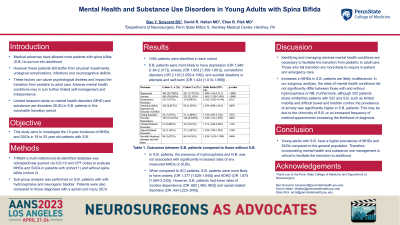Incidence of Mental Health and Substance Use Disorders in Young Adults with Spina Bifida
Friday, April 21, 2023


Bao Y. Sciscent, BS (she/her/hers)
Medical Student
Penn State College of Medicine
Hershey, Pennsylvania, United States
ePoster Presenter(s)
Introduction: Although medical advances have allowed most patients with spina bifida (S.B.) to survive into adulthood, these patients suffer from physical impairments, urologic complications, and neurocognitive deficits, which can cause psychological distress and impact the transition from pediatric to adult care. Limited research exists on mental health disorders (MHD) and substance use disorders (SUD) in S.B. patients during this vulnerable period. This study aims to investigate the 10-year incidence of MHDs and SUDs in 18-25-year-old S.B. patients.
Methods: A multi-institutional research network (TriNetX) was retrospectively queried to identify and compare the presence of MHDs and SUDs in S.B. patients (cohort 1) to those without S.B. (cohort 2). Sub-group analysis was performed on S.B. patients with hydrocephalus and neurogenic bladder (NB). S.B. patients were further compared to patients with spinal cord injury (SCI).
Results: After propensity score matching, 1494 patients were identified in each cohort. S.B. patients had increased risks of depression (OR 1.949 [1.64-2.317]), anxiety (OR 1.603 [1.359-1.891]), and suicidal ideations/attempts or self-harm (OR 1.424 [1.014-1.999]). Risks of ADHD and eating disorders were comparable between cohorts. S.B. patients also had an increased risk for nicotine dependence (OR 1.546 [1.22-1.959]), but not for alcohol or opioid disorders. The presence of hydrocephalus and NB was not associated with a significantly increased risk of any measured MHDs or SUDs. Compared to SCI patients, S.B. patients were more likely to have anxiety (OR 1.377 [1.028-1.845]) and ADHD (OR 1.875 [1.084-3.242]). However, S.B. patients had lower risks of nicotine dependence (OR .682 [.482-.963]) and opioid-related disorders (OR .434 [.223-.845]). S.B. and SCI patients shared similar rates of depression, suicidal ideations/attempts or self-harm, and alcohol-related disorders.
Conclusion : Young adults with S.B have a higher incidence of MHDs and SUDs compared to the general population. Proper mental health and substance use disorder management are critical to facilitating the transition to adulthood.
Methods: A multi-institutional research network (TriNetX) was retrospectively queried to identify and compare the presence of MHDs and SUDs in S.B. patients (cohort 1) to those without S.B. (cohort 2). Sub-group analysis was performed on S.B. patients with hydrocephalus and neurogenic bladder (NB). S.B. patients were further compared to patients with spinal cord injury (SCI).
Results: After propensity score matching, 1494 patients were identified in each cohort. S.B. patients had increased risks of depression (OR 1.949 [1.64-2.317]), anxiety (OR 1.603 [1.359-1.891]), and suicidal ideations/attempts or self-harm (OR 1.424 [1.014-1.999]). Risks of ADHD and eating disorders were comparable between cohorts. S.B. patients also had an increased risk for nicotine dependence (OR 1.546 [1.22-1.959]), but not for alcohol or opioid disorders. The presence of hydrocephalus and NB was not associated with a significantly increased risk of any measured MHDs or SUDs. Compared to SCI patients, S.B. patients were more likely to have anxiety (OR 1.377 [1.028-1.845]) and ADHD (OR 1.875 [1.084-3.242]). However, S.B. patients had lower risks of nicotine dependence (OR .682 [.482-.963]) and opioid-related disorders (OR .434 [.223-.845]). S.B. and SCI patients shared similar rates of depression, suicidal ideations/attempts or self-harm, and alcohol-related disorders.
Conclusion : Young adults with S.B have a higher incidence of MHDs and SUDs compared to the general population. Proper mental health and substance use disorder management are critical to facilitating the transition to adulthood.
